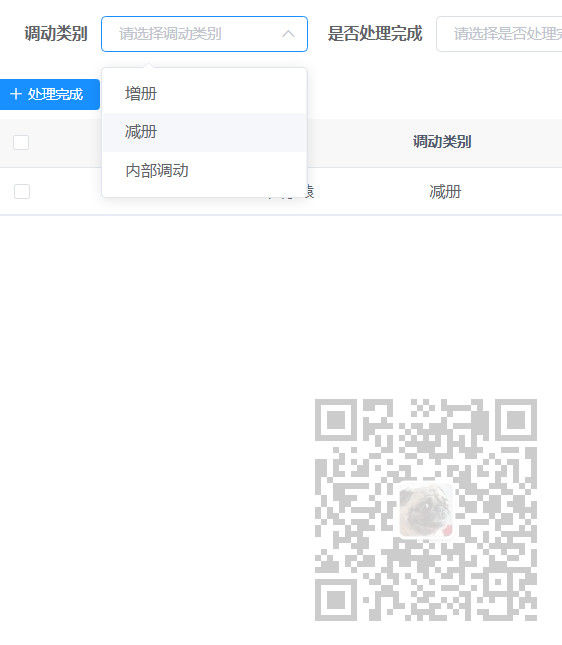场景
Vue+ElementUI+axios+SpringBoot前后端分离的后台管理系统。
将表格中某字段类似于状态等需要关联字典表进行筛选查询时。示例如下

注:
博客:
https://blog.csdn.net/badao_liumang_qizhi
关注公众号
霸道的程序猿
获取编程相关电子书、教程推送与免费下载。
实现
首先实现前端页面下拉框赋值
在页面上添加一个el-table
<el-form-item label="调动类别" prop="ddlb"> <el-select v-model="queryParams.ddlb" placeholder="请选择调动类别" clearable size="small"> <el-option v-for="dict in ddlbOptions" :key="dict.dictValue" :label="dict.dictLabel" :value="dict.dictValue" /> </el-select>
这里绑定的下拉框的数据源是一个ddlbOption这个对象数组,这是一个请求后台数据返回的键值对的数组。
首先需要声明这个对象数组
data() { return { // 调动类别字典 ddlbOptions: [],
然后在页面的created函数中请求后台获取字典数据,这样在页面加载完就能获取数据。
created() { this.getDicts("kq_ddlx").then((response) => { },
调用的方法getDicts是外部引用的公共方法,能根据字典类型获取字典数据
// 根据字典类型查询字典数据信息 export function getDicts(dictType) { return request({ url: '/system/dict/data/type/' + dictType, method: 'get' })
请求的后台url对应的接口中
/** * 根据字典类型查询字典数据信息 */ @GetMapping(value = "/type/{dictType}") public AjaxResult dictType(@PathVariable String dictType) { return AjaxResult.success(dictTypeService.selectDictDataByType(dictType)); }
在Controller层调用servive
public List<SysDictData> selectDictDataByType(String dictType);
在ServiceImpl
public List<SysDictData> selectDictDataByType(String dictType) { List<SysDictData> dictDatas = DictUtils.getDictCache(dictType); if (StringUtils.isNotNull(dictDatas)) { return dictDatas; } dictDatas = dictDataMapper.selectDictDataByType(dictType); if (StringUtils.isNotNull(dictDatas)) { DictUtils.setDictCache(dictType, dictDatas); return dictDatas; } return null; }
到mapper层
public List<SysDictData> selectDictDataByType(String dictType);
对应的xml
<select id="selectDictDataByType" parameterType="SysDictData" resultMap="SysDictDataResult"> <include refid="selectDictDataVo"/> where status = '0' and dict_type = #{dictType} order by dict_sort asc </select>
就是对数据库中的字典表根据type类型进行查询
设计数据库如下

其中dict_lable作为值,dict_value作为键,dict_type相同作为一组,是类型的标志字段。
请求完字典数据并通过
<el-option v-for="dict in ddlbOptions" :key="dict.dictValue" :label="dict.dictLabel" :value="dict.dictValue" />
给下拉框进行赋值后,下面就是对查询数据的格式化显示。
使用字典的目的就是在数据中存储的是键即1,2,3这种数据,而在页面上显示的是要对应的值即中文名 除了可以在后台进行查询时关联字典表进行查询,直接将查询结果返回给前端后。
还可以直接查询的就是表中存储的1,2,3这种数据,然后返回给前端,由前端进行格式化显示。
来到对应的状态列
<el-table-column label= "调动类别" align= "center" prop= "ddlb" :formatter= "ddlbFormat" />
添加格式化属性和方法,在格式化方法中
// 调动类别字典翻译 ddlbFormat(row, column) { return this.selectDictLabel(this.ddlbOptions, row.ddlb); },
传递的row是当前行对象,column是当前列对象
return返回的就是当前列要显示的值,这里调用的是一个方法,传递的是上面获取的字典的数组和当前列的属性值即1,2,3这种。
调用的回显字典数据的方法
// 回显数据字典 export function selectDictLabel(datas, value) { var actions = []; Object.keys(datas).map((key) => { if (datas[key].dictValue == ('' + value)) { actions.push(datas[key].dictLabel); return false; } }) return actions.join(''); }
能将上面查询的字典的数组根据键1,2,3回显值即中文名称。
这样在下拉框选择之后可以通过
<el-select v-model= "queryParams.ddlb"
绑定的值传递给后台,此时后台获取的是设置的value值即1,2,3等。
其中quarmParams是前端声明的对象,字段与后台的实体类的属性项相对应
queryParams: { pageNum: 1, pageSize: 10, gh: undefined, xm: undefined, ddlb: undefined, ddsj: undefined, kssj: undefined, jssj: undefined, sfclwc: undefined, bmids: undefined, },
查询按钮时调用后台接口
/** 查询调动记录列表 */ getList() { listDdjl(this.queryParams).then((response) => { this.ddjlList = response.rows; }); },
此时传递的参数就是
this.queryParams
这个就是上面前端声明的对象,其属性ddlb已经根据el-table的那列进行绑定
<el-select v-model= "queryParams.ddlb"
通过listDdjl请求后台
export function listDdjl(query) { return request({ url: '/kqgl/ddjl/getListBySx', method: 'post', data: query }) }
其中request是封装axios的请求对象
import axios from 'axios' import { Notification, MessageBox, Message } from 'element-ui' import store from '@/store' import { getToken } from '@/utils/auth' import errorCode from '@/utils/errorCode'< /A> axios.defaults.headers['Content-Type'] = 'application/json;charset=utf-8' // 创建axios实例 const service = axios.create({ // axios中请求配置有baseURL选项,表示请求URL公共部分 baseURL: process.env.VUE_APP_BASE_API, // 超时 timeout: 10000 }) // request拦截器 service.interceptors.request.use(config => { // 是否需要设置 token const isToken = (config.headers || {}).isToken === false if (getToken() && !isToken) { config.headers['Authorization'] = 'Bearer ' + getToken() // 让每个请求携带自定义token 请根据实际情况自行修改 } return config }, error => { console.log(error) Promise.reject(error)< BR> }) // 响应拦截器 service.interceptors.response.use(res => { // 未设置状态码则默认成功状态 const code = res.data.code || 200; // 获取错误信息 const message = errorCode[code] || res.data.msg || errorCode['default'] if (code === 401) { MessageBox.confirm( '登录状态已过期,您可以继续留在该页面,或者重新登录', '系统提示', { confirmButtonText: '重新登录', cancelButtonText: '取消', type: 'warning' } ).then(() => { store.dispatch('LogOut').then(() => { location.reload() // 为了重新实例化vue-router对象 避免bug }) }) } else if (code === 500) { Message({ message: message, type: 'error' }) return Promise.reject(new Error(message)) } else if (code !== 200) { Notification.error({ title: message }) return Promise.reject('error') } else { return res.data } }, error => { console.log('err' + error) Message({ message: error.message, type: 'error', duration: 5 * 1000 }) return Promise.reject(error) }< BR> ) export default service
传递到后台接口
@GetMapping("/list") public TableDataInfo list(KqDdjl kqDdjl) { startPage(); List<KqDdjl> list = kqDdjlService.selectKqDdjlList(kqDdjl); return getDataTable(list); }
此时的实体类KqDdjl 的属性要与前端传递的参数的属性相对应,这样后台就能获取到。
public class KqDdjl extends BaseEntity { private static final long serialVersionUID = 1L; /** id */ private Long id; /** 调动类别 */ @Excel(name = "调动类别") private String ddlb; }
省略其他属性和get和set方法。
Controller层传递一直到mapper层
public List<KqDdjl> selectKqDdjlList(KqDdjl kqDdjl);
对应的xml方法
<select id="selectKqDdjlList" parameterType="KqDdjl" resultMap="KqDdjlResult"> <include refid="selectKqDdjlVo"/> <where> <if test="ddlb != null and ddlb != ''"> and ddlb = #{ddlb}</if> </where> </select>
省略其他属性字段和映射等。
这样就可以实现根据筛选的条件查询出符合条件的数据。